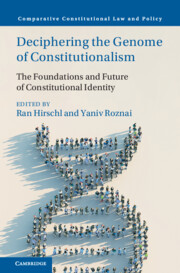Book contents
- Deciphering the Genome of Constitutionalism
- Comparative Constitutional Law and Policy
- Deciphering the Genome of Constitutionalism
- Copyright page
- Contents
- Figures
- Contributors
- Preface
- Acknowledgments
- Introduction
- Part I Foundations, Theory, and Concepts
- Part II Comparative Perspectives
- 8 Confucian Constitutional Identity
- 9 ‘(A-)Religious & Democratic’ Militant Dual Constitutional Identities and the Turn to Illiberalism
- 10 Constitutional Identity in Bangladesh
- 11 Clashing Identities?
- 12 Imposed Revolution?
- 13 India
- Part III American Constitutionalism and Constitutional Identity
- Part IV Emerging Trends
- Index
- References
13 - India
A Constitution in Search of an Identity
from Part II - Comparative Perspectives
Published online by Cambridge University Press: 14 March 2024
- Deciphering the Genome of Constitutionalism
- Comparative Constitutional Law and Policy
- Deciphering the Genome of Constitutionalism
- Copyright page
- Contents
- Figures
- Contributors
- Preface
- Acknowledgments
- Introduction
- Part I Foundations, Theory, and Concepts
- Part II Comparative Perspectives
- 8 Confucian Constitutional Identity
- 9 ‘(A-)Religious & Democratic’ Militant Dual Constitutional Identities and the Turn to Illiberalism
- 10 Constitutional Identity in Bangladesh
- 11 Clashing Identities?
- 12 Imposed Revolution?
- 13 India
- Part III American Constitutionalism and Constitutional Identity
- Part IV Emerging Trends
- Index
- References
Summary
Discussions around Indian constitutional identity often focus upon the Constitution’s “basic structure”, as articulated by the judgment of the Indian Supreme Court by Kesavananda Bharati. In this essay, I attempt to interrogate – and expand – that discussion. Following upon the work of Professor Gary Jacobsohn, I argue that identity, as articulated through the basic structure, is best understood as dynamic and contested, rather than concrete and unchanging. I also argue that the basic structure does not tell the complete story of Indian constitutional identity. That story needs us to understand the Indian Constitution through the lens of power, and how the Constitution organises power relations. A study of constitutional identity through the lens of power reveals – broadly – a “centralising drift” that is present both in the constitutional text and in judgments interpreting the text. While the “centralising drift” might be a dominant feature of Indian constitutional identity at the present moment, it is also important to remember that, as in its more substantive avatar, this version of constitutional identity, too, is contested, revisable, and always open to transformation.
Keywords
- Type
- Chapter
- Information
- Deciphering the Genome of ConstitutionalismThe Foundations and Future of Constitutional Identity, pp. 163 - 176Publisher: Cambridge University PressPrint publication year: 2024

